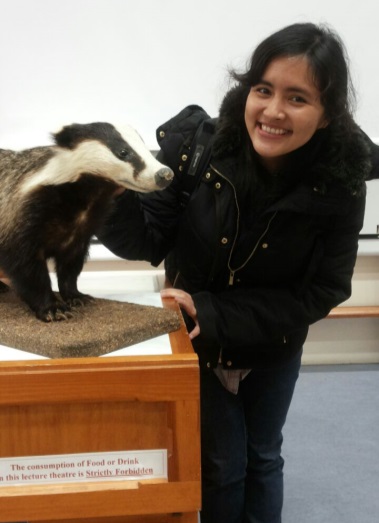Dr Nadine Adrianna Sugianto
Alumni
I pursued my undergraduate degree in Veterinary Medicine (Bogor Agricultural University, Indonesia) where I worked on the ‘Reproduction Potency and Reproduction System Morphology of The Javan Slow Loris (Nycticebus javanicus)’, a critically endagered primate of Indonesia, carried out in collaboration with International Animal Rescue located in Bogor (slow loris sanctuary).
In October 2014, I then continued to conduct my DPhil in WildCRU – Dept. of Zoology, University of Oxford with a scholarship from the Indonesia Endowment Fund for Education (LPDP). For my DPhil, I worked under The Badger Project (Wytham Woods-Oxfordshire) on reproductive biology of the European badger (Meles meles), utilising endocrinological measures with complementary somatic and ecological data, closely investigating physiological mechanisms linked to lifetime reproductive events, cub development, and responses to ecological factors (graduated in 2018).
I subsequently taught Biology in EF Academy Oxford before taking up my current post in April 2020 as Post Doctoral Research Fellow at Birmingham University – School of Biosciences – Locomotor Ecology and Biomechanics Lab, where I am working on The Orangutan Enclosure Design Tool (EDT) Project at BOSF, Kalimantan-Indonesia. My research focus is to test the effectiveness of the EDT in preparing sanctuary orangutans for release and quantify post-release behavioural profiles to produce a refined pre-release assessment and post-release monitoring tool. I am also further exploring the aspects of orangutan locomotion, nest building, social learning, and neophobia/exploratory behaviour.
Publications:
Sugianto et al. (2018) Linking plasma sex steroid hormone levels to the condition of external genitalia morphology (EGM) in European badgers (Meles meles): A critical evaluation of traditional field methodology. Mammalian Biology, 93, 97-108.
Sugianto, N. A., Newman, C., Macdonald, D. W., & Buesching, C. D. (2019). Heterochrony of puberty in the European badger (Meles meles) can be explained by growth rate and group-size: Evidence for two endocrinological phenotypes. PloS one, 14(3).
Sugianto, N. A., Newman, C., Macdonald, D. W., & Buesching, C. D. (2019). Extrinsic factors affecting cub development contribute to sexual size dimorphism in the European badger (Meles meles). Zoology, 135, 125688.
Sugianto, N. A., Buesching, C. D., Macdonald, D. W., & Newman, C. (2019). The importance of refining anaesthetic regimes to mitigate adverse effects in very young and very old wild animals: the European badger (Meles Meles). Journal of Zoological Research, 3(3).
Allen, T. M., Sugianto, N. A., Ryder, C., Newman, C., Macdonald, D. W., & Buesching, C. D. (2019). Encoded Information Within Urine Influences Behavioural Responses Among European Badgers (Meles meles). In Chemical Signals in Vertebrates 14 (pp. 38-59). Springer, Cham.
Sugianto, N. A. (2018). Reproductive biology of the European badger (Meles meles): Endocrinological insights into lifetime reproductive events, strategies and cub development in response to ecological factors (Doctoral dissertation, University of Oxford).
Sugianto, N. A., Newman, C., Macdonald, D. W., & Buesching, C. D. (2020). Reproductive and Somatic Senescence in the European Badger (Meles meles): Evidence from Lifetime Sex-Steroid Profiles. Zoology. In Press.






